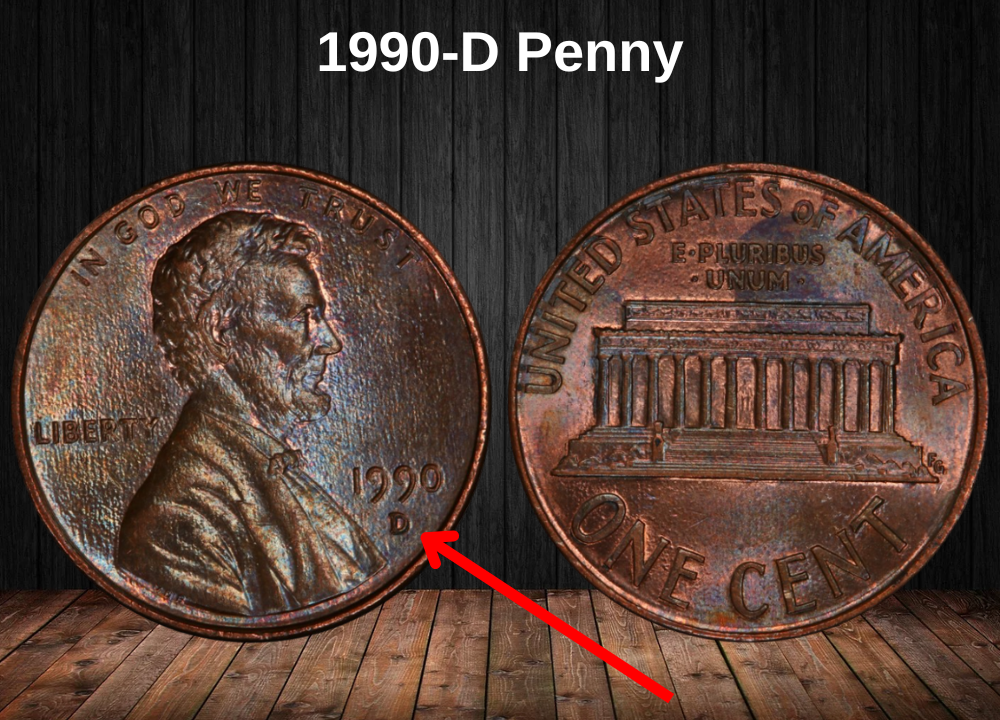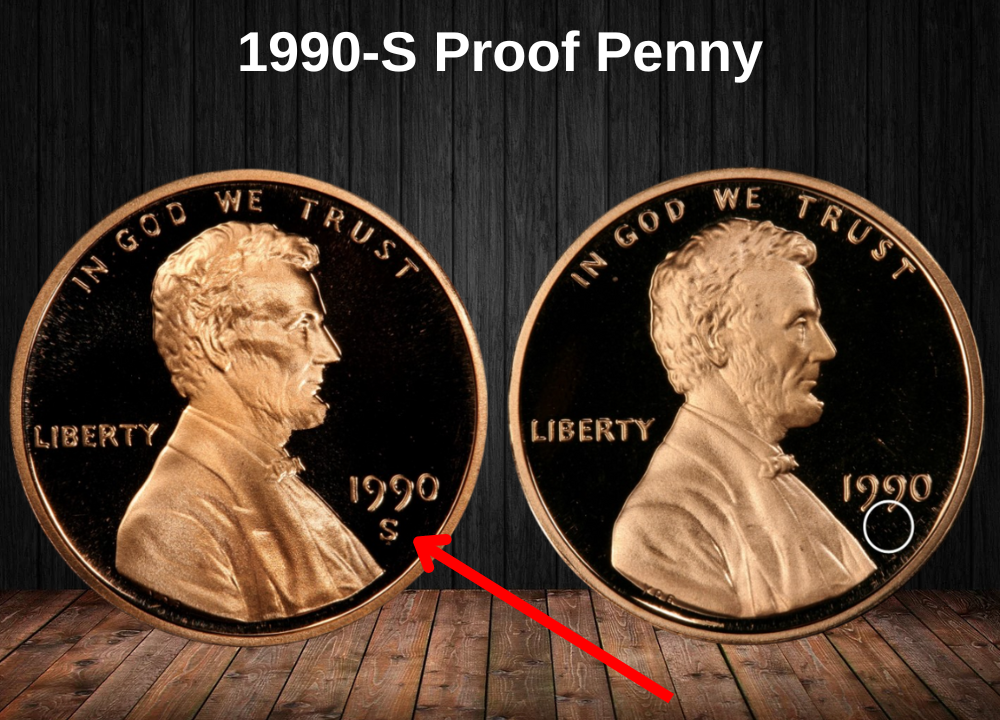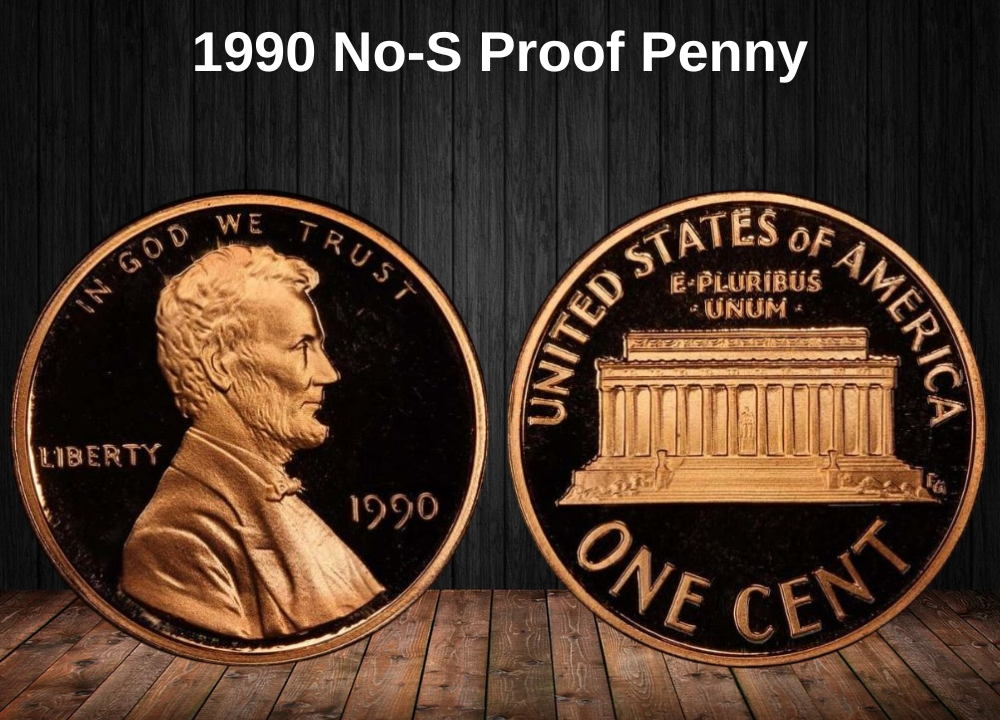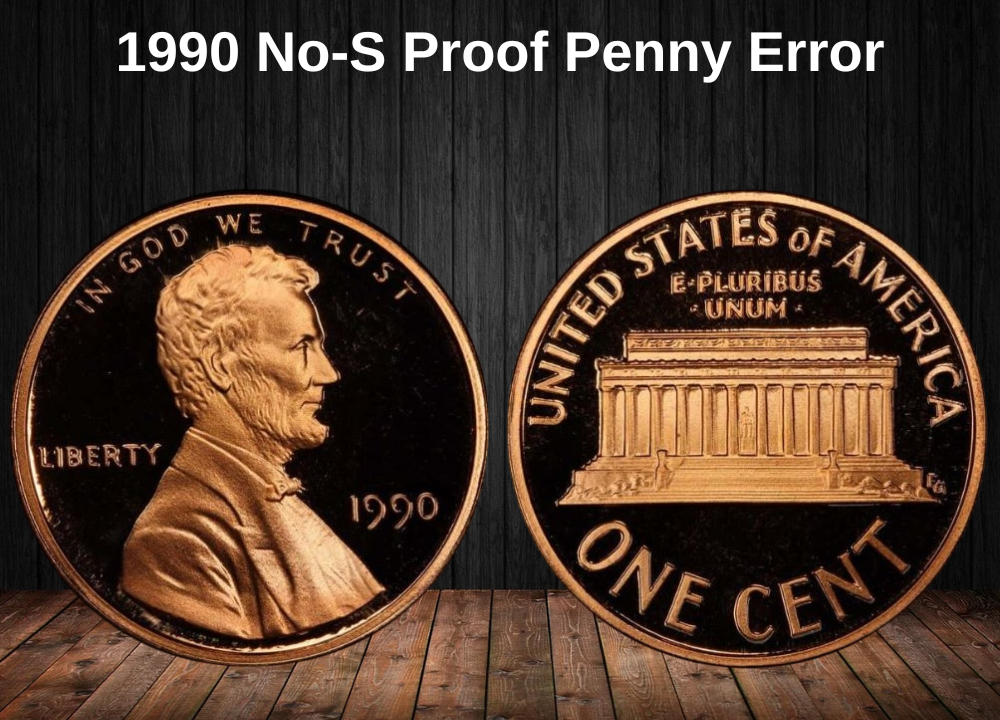Pennies are fascinating little coins. In 2023, it actually costs nearly 3 cents to produce a single penny, meaning the U.S. Mint loses money on every one made—and their purchasing power is so low they can’t even buy a piece of candy! Yet, for some reason, we remain oddly attached to these coins, so they keep being minted and collected.
Now, let’s explore the 1990 Penny Value and see what potential profit they might hold.
1990 Penny Value Chart (Red Grade Coins)
| Coin Type | MS 63 | MS 65 | MS 67 | MS 68+ | MS 69 | PR/PF 69 DCAM |
|---|---|---|---|---|---|---|
| 1990 (P) No Mint Mark | $5 | $10 | $45 | $1,000 | $7,500 | — |
| 1990-D Penny | $6 | $10 | $24 | $350 | $3,000 | — |
| 1990-S Proof Penny | — | — | — | — | — | $14 |
| 1990 No-S Proof Penny | — | — | — | — | — | $6,400 |
Note: Values are for coins graded in Red condition.
History of the 1990 Penny

The Spanish Silver Dollar was the most widely used coin in early U.S. history. While other coins circulated, people favored this one the most. Interestingly, it wasn’t always used as a whole unit—it could be physically cut into eight wedges called bits. Besides that, there were Half Dimes made of silver, and smaller denominations such as the 1-cent, 2-cent, and 3-cent coins. The 1-cent pieces were commonly known as pennies.
The Large Cent was introduced in 1793, just one year after the U.S. Mint began operations. The 2-cent coin came later, in 1864, but lasted only until 1873. The 3-cent coin appeared slightly earlier in 1851 but was also discontinued in 1873, leaving the penny as the sole copper coin in circulation. Even before that, Half Cents, made of pure copper, circulated from 1793 to 1857. It’s worth noting that all U.S. coins contain some copper.
Even gold and silver coins contained about 10% copper to make them easier to mint. Modern precious metal coins have 0.1% to 1% copper for the same reason. While pennies held the highest copper content until 1982, they now have the lowest copper percentage, which might seem ironic since pennies are still the only coins with a copper appearance. This brings us to the concept of the Johnson Sandwich.
Coin Shortages and the Johnson Sandwich
In the 1960s, rising silver prices led to widespread coin hoarding and melting. To combat this, the U.S. Mint stopped using mint marks from 1965 to 1967 and eventually removed silver from coins altogether. They replaced it with a copper core coated in 75% copper and 25% nickel, a combination nicknamed the Johnson Sandwich after President Lyndon B. Johnson, the 36th U.S. President.
This change meant most U.S. coins switched to 91.67% copper and 8.33% nickel, giving them a silver-like shine reminiscent of late 18th-century coins. Only pennies retained their copper color. From 1909 to 1981, pennies were 95% copper, but this dropped sharply to 2.5% copper in 1982. The Mint briefly tested aluminum pennies but settled on zinc as the core metal.
Although pennies are well known for their copper hue, some rare exceptions exist:
- Steel War Pennies minted during 1942 to 1944 have a silver-gray look, made to conserve copper and nickel for WWII efforts.
- Experimental aluminum pennies also exist and are quite rare and valuable.
Metal Composition and Mint Marks
Originally, pennies were large (28.5 mm) and made of pure copper. In 1857, their size decreased to 19.05 mm and the metal changed to 88% copper and 12% nickel. By 1864, the composition shifted again to 95% copper with 5% zinc or tin. These adjustments responded to fluctuations in copper prices—most notably in the late 1970s and early 1980s.
Thus, in 1982, pennies switched to a 97.5% zinc core with a 2.5% copper coating. Around this time, other coins started regularly using the “P” mint mark for Philadelphia, starting in 1980. Before this, Philadelphia only used mint marks during the War Years (1942–1945), and those marks were notably large to help distinguish them.
Interestingly, pennies did not carry the P mint mark after 1982, except for special occasions:
- In 2017, to commemorate the 225th Anniversary of the U.S. Mint, pennies bore the “P.”
- In 2019, pennies from the West Point Mint displayed a “W” mint mark celebrating the 110th Anniversary of the Lincoln Cent. Earlier, from 1983 to 1986, West Point pennies had no mint marks.
As you might expect, mint marks impact the resale value of coins, making these variations important for collectors.
Features of the 1990 Penny
The Obverse of the 1990 Penny

The coin shows Abraham Lincoln facing right. Above his head is the motto “IN GOD WE TRUST”, while the word “LIBERTY” appears on the left, behind his neck. The mint mark and mint date are located to the right, in front of his chest. Near the cut-off of Lincoln’s shoulder, you can find the initials “VDB”, representing the coin’s designer, Victor David Brenner.
The Reverse of the 1990 Penny

The coin features the Lincoln Memorial Building, with Lincoln’s statue visible in the center. On the right corner of the memorial, you’ll find the initials “FG”, representing the coin’s designer, Frank Gasparro. The top edge of the coin reads “UNITED STATES OF AMERICA”, followed by the motto “E PLURIBUS UNUM” just below it. At the bottom, the coin displays the denomination: “ONE CENT.”
Other Features of the 1990 Penny
The 1990 penny is composed of 97.5% zinc with a 2.5% copper coating, which helps it maintain its classic copper color. It measures 19.05 mm in diameter and weighs 2.5 grams. The coin has plain (smooth) edges without any reeding. Pennies are typically graded by color as Red, Brown, or Red-Brown, reflecting their condition and copper tone.
1990 Penny Grading Overview
Grading pennies involves three key factors:
- Sheldon Scale: Scores coins from 1 to 70, with higher numbers indicating better condition.
- Color Grade:
- RD (Red) — Most valuable
- RB (Red-Brown)
- BN (Brown)
- Reflectivity: Terms like Cameo and Deep Cameo (Ultra Cameo) describe the coin’s shine and contrast. Ultra Cameo coins usually score between 67 and 70 on the Sheldon Scale.
Sheldon Scale Grades
| # | Grade |
|---|---|
| 1 | Basal State-1 |
| 2 | Fair |
| 3 | Very Fair |
| 4, 5, 6 | Good |
| 7, 8, 10 | Very Good |
| 12, 15 | Fine |
| 20, 30 | Very Fine |
| 40 | Extremely Fine |
| 50 | About Uncirculated |
| 60 | Mint State |
| 65 | Mint State |
| 70 | Mint State |
Checking your coin against these grades is essential to accurately determine its value.
1990 Penny Value Guides
1990 No-Mint-Mark Penny Value

In 1990, the Philadelphia Mint produced 6,851,765,000 pennies without mint marks. Although these coins are over 30 years old, they are still considered relatively young in the coin collecting world, which makes high grades easier to obtain.
- In April 2022, an MS 69 Brown (BN) penny sold for $4,300 on eBay.
- An MS 69 Red (RD) penny sold for $7,200 in June 2018.
- Since only two MS 69 pennies have appeared so far, their value in January 2025 has increased to $7,500.
1990-D Penny Value

The Denver Mint produced 4,922,894,533 pennies with the D mint mark in 1990. On May 18, 2021, an MS 69 Red (RD) penny was sold on eBay for $2,938.
Fewer than ten MS 69 specimens have been submitted to PCGS, so their estimated value in January 2025 is around $3,000.
However, rarity matters—with nearly 300 coins graded MS 68, their value is only about $100, which pulls down the value of the two MS 68+ coins to approximately $350.
1990-S Proof Penny Value

Proof coins can come in three finishes:
- Mirror-like (standard proof)
- Reverse proof
- Matte proof (aka satin finish)
In 1990, the San Francisco Mint produced mirror-like proof pennies using specialized processes:
- Blanks (planchets) were burnished in vats with 6mm stainless steel beads, giving them a watery, reflective surface.
- Die fields were scrubbed with horsehair brushes for enhanced clarity.
- Design details were laser-frosted to produce a sharp cameo contrast. This modern computer-based frosting is long-lasting, unlike acid-wash dies, which wore down quickly.
As a result, most 1990 Proof Pennies hold their Deep Cameo (DCAM) or Ultra Cameo grade.
Production and Auction Records
- The San Francisco Mint struck 3,299,559 proof pennies in 1990, all bearing the S mint mark.
- In July 2004, a PR 70 DCAM sold for $2,358.
- However, as of January 2025, PCGS has graded over 500 coins as PR 70 DCAM, bringing the current value down to $65.
- Nearly 6,000 PR 69 DCAMs exist, so their value is just $14.
- A PR 60 DCAM trades for only $1.
1990 No-S Proof Penny Value

Until 1990, mint marks were added manually to coin dies using a hand-held punch. As the last detail added to the master die, this process often led to varieties like:
- RPMs (Re-punched Mint Marks)
- OMMs (Over Mint Marks)
After 1990, mint marks were applied digitally using computerized engraving systems—a major improvement in precision and consistency. But in a rare twist, the San Francisco Mint accidentally omitted the “S” mint mark from a small batch of 1990 proof pennies.
How the Error Happened
- A flawed die without the “S” mint mark was used briefly before being discovered.
- Roughly 3,000 coins were struck before the mistake was corrected.
- These proofs were still finished using the mirror-like techniques (burnished blanks, frosted details), making them visually identical to regular 1990-S proofs—except for the missing “S”.
1990 No-S Proof Penny Sales and Value
- Grading terms:
- PCGS uses the PR prefix (e.g., PR 69 DCAM)
- NGC uses the PF prefix (e.g., PF 69 Ultra Cameo)
Notable Sales:
- A PR 69 BN (Brown) sold on eBay for $5,250 in 2021
- A PR 69 DCAM reached $20,700 in 2007
- However, as 78 examples are now known, the estimated value as of January 2025 is around $6,400
These coins remain among the most coveted modern proof errors, especially for collectors focused on Lincoln cents or minting mistakes.
Rare 1990 Penny Errors List
1990 No-S Proof Penny Error

In 1990, the San Francisco Mint accidentally produced 3,055 Proof Lincoln Cents without the “S” mint mark. At first glance, these coins might be mistaken for regular Philadelphia pennies, since they also lack a mint mark. However, their mirror-like reflective fields and frosted devices reveal their proof origin.
This rare error makes the 1990 No-S Proof Penny a highly sought-after variety. One example graded PR 69 Deep Cameo (DCAM) sold for $20,700 in 2007, but as more were discovered, its value dropped to $8,813 by 2014. Even so, it remains one of the most valuable modern proof coins in the Lincoln Cent series.
1990 (P) Penny – Double Strike and Broad Strike
Modern coin rims are formed in upsetting machines, which give coins a raised border. This keeps coins uniformly shaped and stackable. On this error coin, a second strike caused a broad strike, flattening and widening the rim. It also doubled the inscription “United States”.
- Grade: MS 64 RD
- Sale Price: $150
1990 (P) Penny – Double Struck with 50% Indentation
This coin was struck twice, and on the second strike, the planchet had already partially exited the striking area. This caused a deep indentation and visible deformation, especially in the affected zone.
- Grade: MS 64 RD
- Sale Price: $120
1990 (P) Penny – Doubled Die Obverse (DDO)
This classic hub doubling error happened when the die shifted between hub impressions, causing a double-vision effect on the obverse. Look for doubling in “Liberty” or the date “1990.”
- Grade: MS 65 RD
- Value: $120
You might also find a DDR (Doubled Die Reverse) variant from the same year, valued at around $25 in similar grade.
1990-S Proof Penny – Double Struck in Collar with Obverse Rotation
This San Francisco proof penny was struck twice while held in the collar, but with a slight clockwise rotation between strikes. It caused subtle but clear doubling in Liberty, the date, the “S” mint mark, and “In God We Trust.”
- Grade: PF 67 RD
- Sale Price: $500
1990-D Penny – Struck 45% Off-Center
For a coin to be properly minted, the planchet must align precisely between the obverse and reverse dies. When it’s misaligned, off-center strikes occur. This Denver-minted penny was struck 45% off-center, severely distorting its shape into a figure-8 appearance.
- Grade: MS 62 BN
- Sale Price: $70
1990 (P) Penny – Double Denomination Error
This rare and valuable mint error involves a previously struck coin being re-struck with a different denomination. In this case, a Roosevelt Dime was re-struck with the Lincoln Cent design. The obverse shows Lincoln and FDR overlapping at 90°, and the reverse displays both the Lincoln Memorial and Freedom Torch.
- Grade: MS 65
- Sale Price: $2,280
1990 (P) Penny – Struck on a Dime Planchet
Unlike the previous double denomination error, this mistake occurred when a penny design was struck on a blank intended for a dime. Because dime planchets are smaller and made of different metal, the coin’s appearance is distinctively off. This error type is highly sought-after.
- Grade: MS 65
- Sale Price: $550+
1990 (P) Penny – Foldover Error
During high-speed minting, over a hundred blanks are processed per minute. If one enters the striking chamber incorrectly—perhaps standing vertically or rotating mid-air—a rare foldover error can occur. The result is a coin bent into a semi-circular shape with distorted design elements.
- Grade: MS 62 BN
- Sale Price: $745
1990-D Penny – Struck on a Copper Planchet
By 1990, the U.S. Mint had fully transitioned to zinc-core pennies with a thin copper coating. However, in rare cases, leftover copper planchets from pre-1983 (95% copper, 5% zinc) mistakenly entered production. These weigh 3.1g instead of the modern 2.5g. This Denver-minted error was one such case and is highly valuable to collectors.
- Grade: MS 64 BN
- Sale Price: $5,640
Where to sell your penny?
Now that you know the value of your penny, you might be wondering where to sell it. Don’t worry: here’s a guide to some of the best online platforms where you can easily sell your coins, along with their advantages and disadvantages.
Discover the best platforms for selling coins online (pros and cons).
FAQ about the 1990 Penny
1. Why is the 1990 Lincoln cent a key interest for variety collectors, especially with the “No S” proof variety?
The 1990 No S Proof Lincoln cent is one of the most famous modern U.S. coin rarities. It was struck at the San Francisco Mint but missing the “S” mint mark. Only a few examples were accidentally released. This error occurred due to a proof die not being punched with the S mint mark, making it incredibly valuable — with prices ranging from $10,000 to over $20,000, depending on condition.
2. How can you tell the difference between the rare 1990 No S proof and a regular circulation strike with no mint mark?
A genuine 1990 No S Proof:
- Has sharp mirror-like fields and frosted devices (proof finish).
- Was struck on a high-quality planchet with multiple strikes.
- Lacks the “S” mint mark despite being a San Francisco proof issue.
A regular 1990 Philadelphia penny also lacks a mint mark but is not proof-struck — it has standard luster and strike quality.
3. What are the most valuable varieties of the regular 1990 pennies?
While the No S Proof is the standout, collectors also search for:
- Double die obverses, especially on “LIBERTY” and the date.
- Off-center strikes, broadstrikes, and clipped planchets.
- Die cracks or cuds, which can fetch premiums if dramatic.
4. What is the metal composition of the 1990 penny, and how does it affect its condition over time?
The 1990 penny is made of 97.5% zinc and 2.5% copper plating (the post-1982 composition). This makes it:
- Prone to plating blisters or bubbles if not stored correctly.
- Vulnerable to zinc rot if the copper layer is damaged, especially in humid environments.
5. What mint locations struck 1990 pennies, and how do they compare in strike quality?
Three mints produced 1990 cents:
- Philadelphia (no mint mark)
- Denver (D)
- San Francisco (S) — Proof only
The Denver Mint typically produced coins with better strike quality, while Philadelphia strikes may exhibit weaker details, especially on Lincoln’s hair and the Memorial steps.
6. How can you determine if a 1990 penny is worth submitting for third-party grading?
Look for:
- MS-67 RD or higher grade potential.
- Full luster, no visible marks, and sharp details.
- Clear fields with no zinc spots or discoloration.
PCGS and NGC-certified coins at high grades can sell for $100+, and much more for top pop examples.
7. How does the 1990 penny fit into the broader Lincoln cent series from a historical perspective?
The 1990 cent sits within the late Memorial era (1959–2008) and represents a time of extremely high mintage figures and modern minting technology. However, its value lies in its proof error rarity and being part of the transitional phase leading up to the bicentennial cent redesign in 2009.


















































